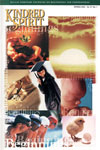Lord of the Rings: Foundations for Marriage
"That is why a man leaves his father and mother and unites with his wife, and they become a new family" (Gen. 2:24, NET BIBLE).
We often hear Genesis 2:24 quoted either as an example of God's command given to the husband or as sage advice to newlyweds who are considering whether to live with their parents. While the suggestion that a couple must live under a separate roof to establish themselves certainly cuts down on in-law problems, it appears to be more a product of Western wealth and individualism than God's ideal as set forth in Genesis. Dr. Robert Chisholm (ThD, 1983), Dallas Seminary's professor of Old Testament studies, notes, "This statement is an editorial comment, not an extension of the quotation 'bone of my bones, flesh of my flesh …' (Gen. 2:23). The statement describes what typically happens, not what will or should happen. It is saying, 'This is why we do things the way we do.' It links a practice that was contemporary to the narrator with the historical event being narrated. The event described in verse 23—oneness of flesh—provides the basis for the contemporary practice described in verse 24. The verb form has a habitual or characteristic nuance. (For other examples see Genesis 10:9; 32:32; Numbers 21:14, 27; 1 Samuel 5:5; 19:24; and 2 Samuel 5:8.)
"The verb translated 'leave' normally means 'to abandon; to forsake; to leave behind; to discard,' when used with human subjects and objects. Within the context of the ancient Israelite extended family structure, this cannot refer to emotional or geographical separation. It's not a command to move out and start a new household. The narrator is using hyperbole to emphasize the change in perspective that typically overtakes a young man when his thoughts turn to love and marriage."
So this passage is not an exhortation to the groom or couple but rather something the in-laws should keep in mind: Don't fight nature. Their son is going to transfer loyalty to his wife, and that is part of God's design.
"To the woman he said, 'I will greatly increase your pains in childbearing; with pain you will give birth to children. Your desire will be for your husband, and he will rule over you'" (Gen. 3:16).
Somtimes at marriage conferences, speakers teach that Genesis 3:16 outlines God's ideal for the husband-wife relationship. But is that really what this text says?
In Creation and Blessing Dr. Allen Ross (ThM, 1969; ThD, 1977) points out that the same combination of the words "rule" and "desire" that we see here shows up again in the next chapter—in Genesis 4:7—where "desire" means prompting to evil and "rule" means mastery. In both cases the desire/rule combination refers to a power struggle. Ross notes, "The significant point about [Genesis 3:16] is that it is part of the punishment oracle for sin. To attempt to make it teach the submission of the woman to her husband and the loving leadership of the husband to his wife completely misses the point.… It may be argued that the male domination in the history of the human race is a perpetual reminder of the Fall." He concludes that the point of this text is that "woman at her worst would be a nemesis to the man, and the man at his worst would dominate the woman."
In the same way that disease, death, weeds, and the confusion of languages come as consequences of sin, the marriage relationship will suffer the results of the Fall. But that does not negate the need for medicine, fertilizer, language school, or good marriage counsel. Until the new heavens and the new earth come, we strive against the effects of the Fall rather than embracing them.
"Let the king bring me into his chambers" (Song of Sol. 1:4).
Pick up popular books about Song of Solomon today and you'll find authors who see the book as depicting a couple's relationship chronologically from courtship through marriage. Thus the Song's early chapters are said to describe a dating couple. Yet young couples in the ancient Near East didn't "date"—they had arranged marriages.
Dr. Gordon Johnston (ThM, 1985; ThD, 1992), Dallas Seminary's associate professor of Old Testament studies, offers a better understanding:
"A cycle of desire-fulfillment recurs throughout each of the major literary units in the Song. Rather than tracing a straight-line narrative progression from desire to courtship in the first half of the book to fulfillment in marriage in the second half, this movement from desire to fulfillment recurs no fewer than ten times in a cyclic pattern. This clearly suggests a cyclic (poetic) rather than linear (narrative) structure for the Song.
"Since the discovery of several collections of ancient Egyptian love songs (Dynasties 19–20: ca. 1320–1100 B.C.), many scholars see the Song as belonging to the genre of ancient Near Eastern love poetry.
"Viewing it as a collection of the best individual love poems finds analogy with two other works traditionally attributed to Solomon—Proverbs and Ecclesiastes, collections of wisdom-sayings.
"Rather than superimposing a story line to explain the relation of one passage to the next, we may simply read the thirty to forty literary units in the Song as individual self-enclosed love poems. Viewing the book as a collection/anthology of several sets of individual poems provides a better explanation for several features that seem to defy explanation in the chronological/narrative approach."

